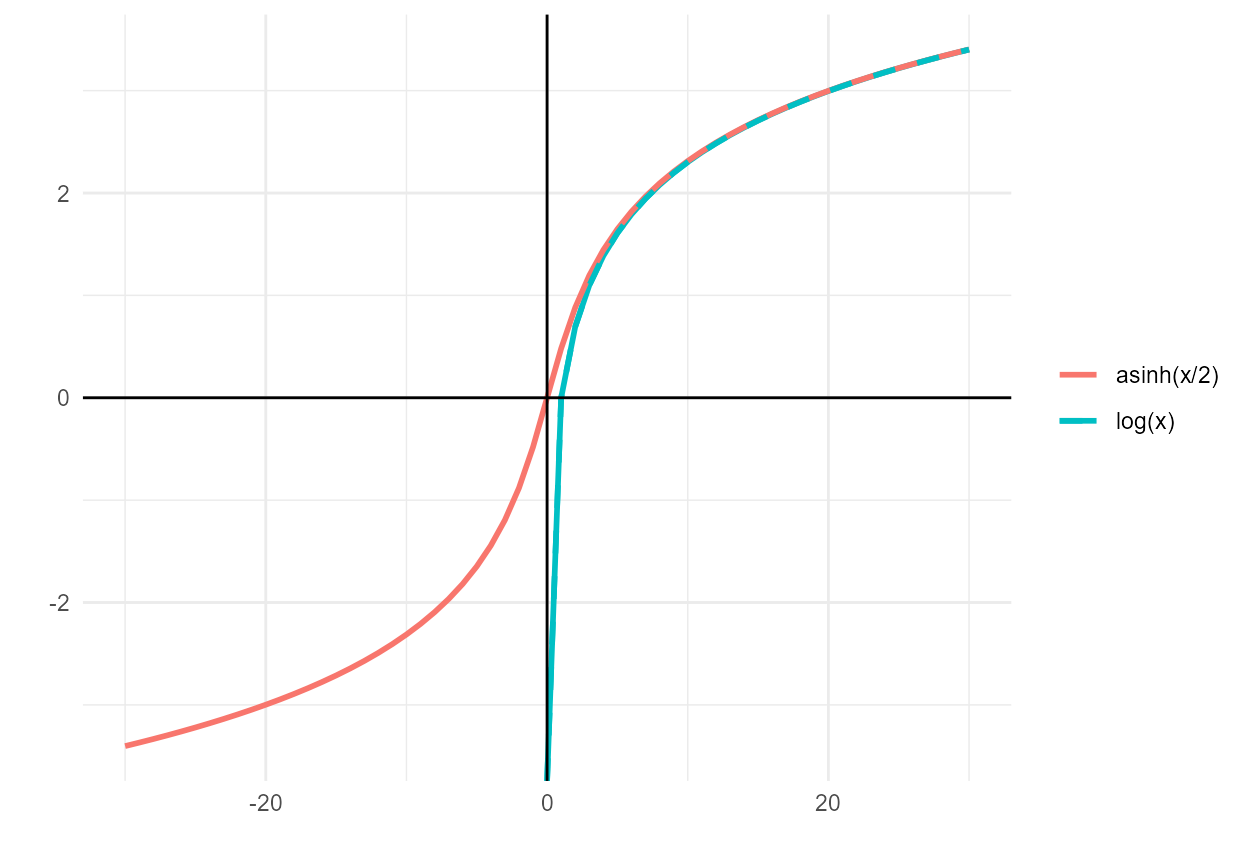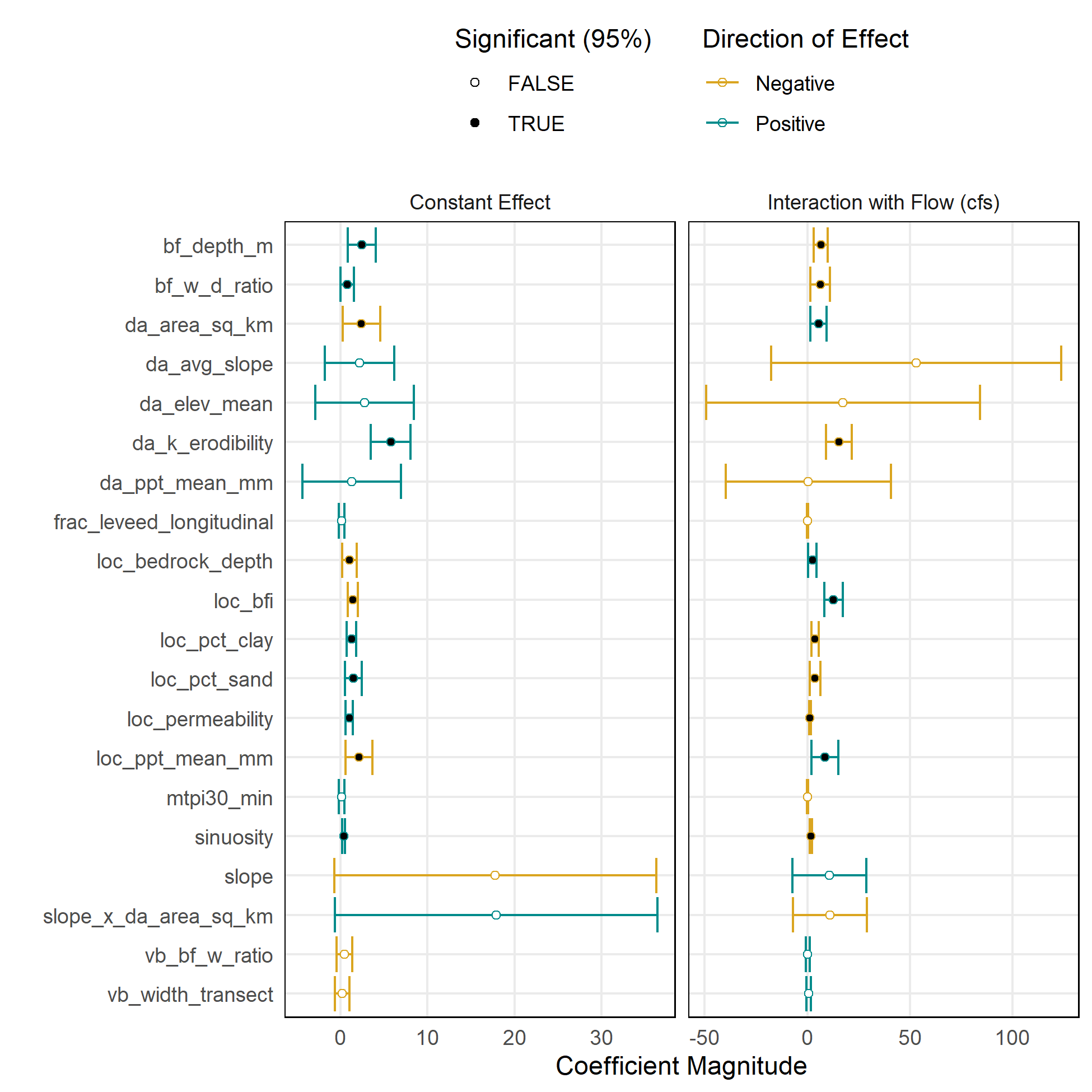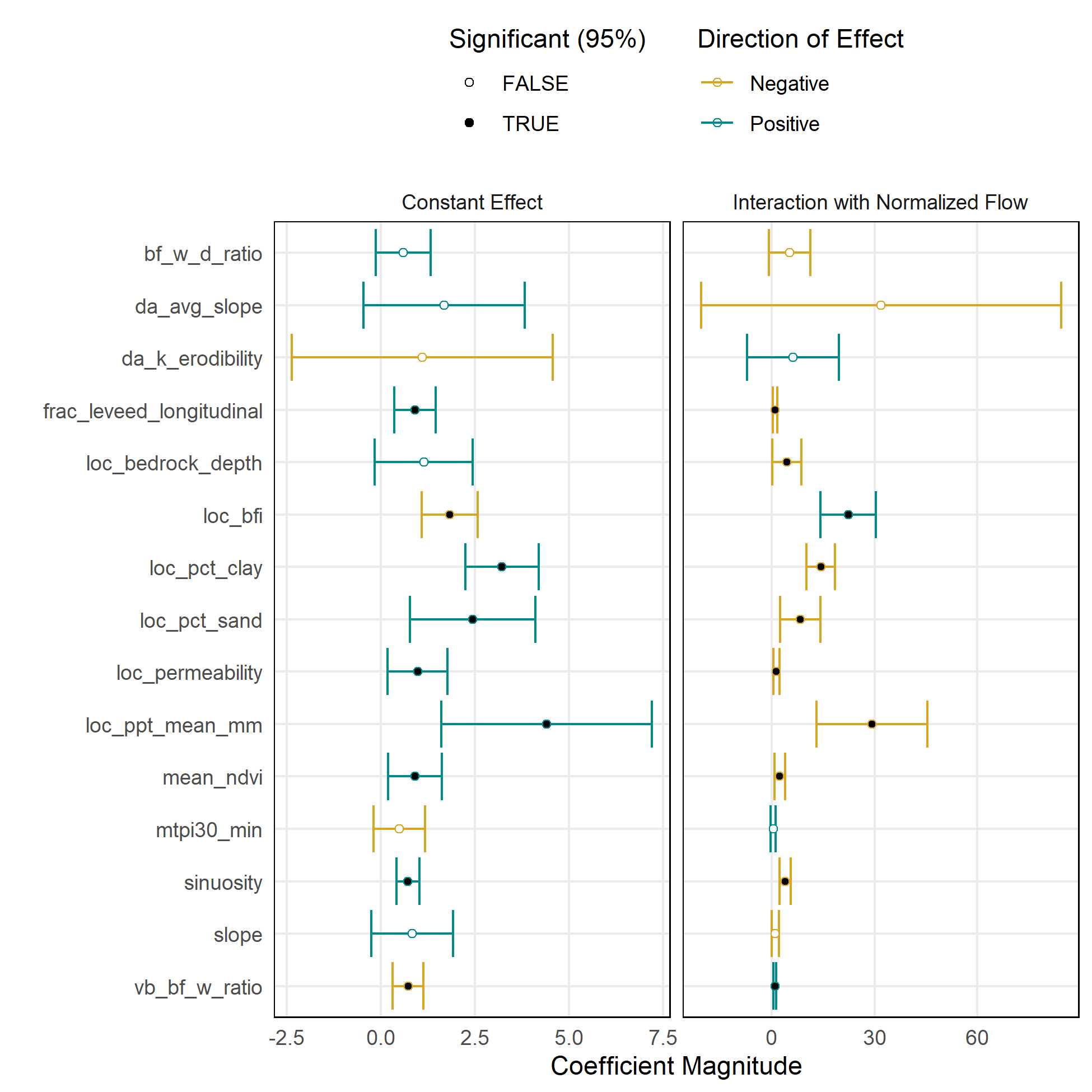Statistical Model Development, Training, and Prediction
Maddee Wiggins & Skyler Lewis
2025-03-04
statistical_model.RmdThe hydraulically modeled flow-to-suitable-area relationships developed for reaches in Step 2 are joined to the reach predictor variable table from Step 1. This dataset (one observation per flow per reach) is then used to train a statistical model that can be used to predict flow-to-suitable-area curves for reaches that are not hydraulically modeled. Random Forest Regression, a decision tree-based machine learning approach, allows for non-linear relationships between suitable habitat, flow, and the array of predictor variables.
Introduction
We are currently developing and refining a statistical model to predict flow-to-suitable-habitat-area relationships for stream reaches in the Sacramento-San Joaquin Basin, based on a variety of widely-available geospatial and hydrologic variables. Predictor variable data collection is detailed in the Predictor Variables article.
This statistical model method was developed for predicting rearing
habitat area versus flow at the comid scale.
It is also applied for spawning habitat area, given training data generated using different habitat suitability indices (see Habitat Training Data), with additional post-model filters required to eliminate areas that are non-suitable due to substrate (see Spawning Extents).
Raw outputs from this method are then ready to be scaled based on hydrology and duration requirements (see Duration Analysis) and/or aggregated at the river or watershed level (see Watershed Aggregation).
Model Development
General Model Form
In practice, suitable habitat area is modeled as a function of flow, the suite of predictor variables, and the interactions between each predictor variable and flow. As applied in a linear regression model, the general functional form for the model is as follows. The use of the interaction terms allows the model to estimate not only the average effect of each predictor variable on suitable area, but also the effect of each predictor variable on the flow-to-suitable-area relationship.
- = suitable habitat area, WUA per linear ft (response variable)
- = streamflow (cfs)
- = matrix of predictor variables (slope, drainage area, etc.)
- = estimated intercept
- = estimated coefficient on flow (i.e. constant effect of flow on habitat)
- = estimated coefficients of predictor variables (i.e., constant effect of each predictor on habitat)
- = estimated coefficients of interactions (i.e., effect of each predictor on the flow-to-habitat relationship)
- = error term
Expressed without using matrix notation, the model estimate for each NHD ComID reach and flow is…
… and so on for all other predictor variables with estimated coefficients , , , , etc.
Transformations and Weights
We originally log-transformed the habitat, flow, and predictor variables for three reasons: (a) to limit the effect of extreme values; (b) to align with typical hydrologic conventions of using power series models; and (c) for interpretability because log-log model coefficients represent elasticities (“percent change in y per percent change in x). Because some predictor variables include values less than or equal to zero, the log transformation was replaced with a variation on the inverse hyperbolic sine (asinh) transformation. Because , this transformation behaves like a log transformation for positive values () but remains defined for zero values and has a comparable, mirrored shape for negative values.
Additionally, all predictor variables were centered and scaled after transformations were applied.
The length (linear ft) of each reach (comid) was applied
as a case weight. Reaches vary substantially in length from several feet
to 26 miles, with a mean length of 1.2 miles. Weighting the estimate by
linear ft allows longer reaches to have greater influence on the model
and makes the somewhat arbitrary comid delineations less
relevant.

Flow Variable
Training flow data are resampled to a regular sequence of flows that is evenly spaced on a logarithmic axis:
interp_flows <- habistat::seq_log10(50, 15000, 0.05, snap=100)
Model Versions Tested
Two forms of the model were tested, discussed in sequence in the following sections.
Model Version 1: Habitat Area/LF vs Flow
This is the simplest and most straightforward version of the model.
Habitat variable: Suitable habitat area (WUA) per linear ft, aka “effective habitat width”
Flow variable: Flow (cfs)
Predictor variables:
- Reach characteristics: slope, bankfull depth, bankfull width-depth ratio, baseflow index, % clay, % sand, permeability, depth to bedrock, mean annual precipitation, MTPI (topographic position index), valley bottom width, valley bottom-bankfull width ratio, fractional levee confinement, channel sinuosity
- Catchment characteristics: drainage area, mean elevation, mean annual precipitation, avg erodibility, avg slope, avg NDVI
Transformations:
- Inverse hyperbolic sine
- Interaction between slope and drainage area
- Center and scale all predictors
Model forms: Linear regression; Random forest regression
Model Version 2: Normalized Habitat Area/LF vs Normalized Flow
This model is a variation on Version 1. It is intended to deal with the problem of differing ranges of flows across training datasets on account of the differing sizes of the river systems.
A scalar was defined for each reach (comid),
representing the magnitude of flow in the watershed. A product of the
drainage area and mean annual precipitation with units of million acre
feet (Maf), this value represents the average quantity of water input
into the reach’s catchment in a year:
The habitat and flow variables are multiplied by this scalar prior to prediction, then divided by the scalar after prediction.
Habitat variable: Suitable habitat area (WUA) per linear ft normalized by DA*MAP
Flow variable: Flow (cfs) normalized by DA*MAP
Predictor variables:
- Reach characteristics: slope,
bankfull depth, bankfull width-depth ratio, baseflow index, % clay, % sand, permeability, depth to bedrock,mean annual precipitation, MTPI (topographic position index), valley bottom width, valley bottom-bankfull width ratio, fractional levee confinement, channel sinuosity- Catchment characteristics: drainage area, mean elevation, mean annual precipitation, avg erodibility, avg slope, avg NDVI
Transformations:
- Inverse hyperbolic sine
Interaction between slope and drainage area- Center and scale all predictors
Model forms: Linear regression; Random forest regression
Compared to Version 1, the normalized Version 2 model creates flow-to-suitable-area curves that are more strongly proportional to the size of the river.
Exploratory Linear Regression
Linear regression was useful for exploring the effects of predictor variables and testing different model forms. However, the collinearity between variables and the limitations on the functional shape of relationships were limitations.
| Model Version 1: Scale-Dependent | Model Version 2: Scale-Normalized |
|---|---|
 |
 |
Random Forest Regression Model
Random Forest Regression is a decision tree based machine learning
alternative to linear regression. The model specifications are
essentially identical to the linear regression formulations previously
discussed. Unlike linear regression, there is no constraint on the
functional form of the flow-to-habitat relationship or the effects of
predictor variables. Random forest models are fit using the
ranger package via the tidymodels
framework.
Train/Test Split: Flowlines (
comids) and their associated training data are split into training and testing datasets at a 75% training/25% testing random split, stratified by river and hydrologic class.IHS Transformation: As described in the section above, all continuous numeric variables are transformed using the transformation . Variables that represent proportions or ratios are not transformed. The response variable is also transformed.
DA/MAP Normalization: For the “scale-normalized” model, all variables are divided by the scaling factor described above.
Interaction: Any predictor variables included in the model are also included as interactions with flow: .
Feature Selection: The training dataset is used for feature selection, i.e., identifying the set of predictor variables to be used in the prediction. We iteratively test versions of the model with and without each predictor variable. Predictor variables selected for inclusion are those that improve model fit (decrease RMSE) when they are included relative to when they are excluded.
Parameter Tuning: Random forest model parameters are tuned using 10-fold cross-validation with the training dataset. Tuned parameters are the number of trees (
trees), number of predictors that will be randomly sampled at each split when creating the tree models (mtry), and the minimum number of data points in a node that are required for the node to be split further (min_n).Prediction: Once a final tuned model has been selected, the full dataset of flowlines (
comids) and their attributes are input, once for each flow along a a regular log sequence of flows matching theinterp_flowssequence described above. Predictions are run for allcomids; filters are applied after the fact.Inverse IHS Transformation: Transformed variables and the final output are reverse-transformed using .
Inverse DA/MAP Normalization: For the “scale-normalized” model, normalization is reversed by multiplying the result by the scaling factor described above.
Results
The trained statistical model can now be used to predict flow-to-suitable-area relationships for other streams within the study area. While the statistical model will produce predictions for any stream with valid predictor data, the validity and trustworthiness of predictions will depend on those streams’ similarity to the training dataset. As training datasets are currently limited to foothill alluvial systems on major tributary streams, only these should be considered valid.